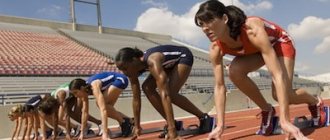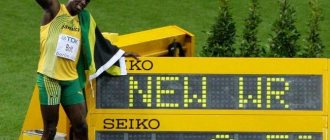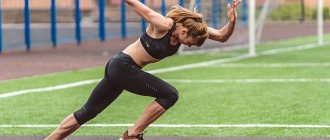What is sprinting
Sprinting is running or racing over short distances at top speeds. This kind of running is called sprinting, and long-distance running is called stayer or marathon running.
Sprint running has a pronounced strength orientation both in terms of body work and in terms of the biochemical and physiological processes that occur in the runner’s body: during sprinting, the muscles of the athlete’s entire body are mobilized, the work of ligaments, cardiac and respiratory systems is activated.
Sprint distances range from 30 to 400 m. Olympic distances are 100, 200 and 400 meters and relay races 4x100 meters and 4x400 meters. The 60-meter race is included in the programs of the World and European Championships. At other competitions there are non-standard distances - 30, 50, 150, 300, 500 meters and a 4x200 meter relay.
50 developmental exercises for training at home
Features of sprint running
Due to the specific nature of the load, sprinting has certain characteristics and effects on the athlete’s body. Firstly, it promotes the development of strength, endurance, and has a positive effect on muscle tone, cardiac and pulmonary systems. We can say that a person’s general well-being improves and his health improves. Secondly, sprinting is an effective stimulator of fat burning. In this case, muscle mass is not burned, but on the contrary, the skeletal muscles of the lower body are built up.
However, despite all the positive aspects, the so-called smooth running is quite traumatic and technically difficult. Therefore, it is not recommended to start with this type. A sprinter is an experienced athlete, previously prepared by trial training for heavier loads. Preparation is associated not only with testing with speed loads, but also with other athletics exercises.
Features of sprint running
Sprint running requires ideal preparation in everything - technique, strength, endurance - strict coordination of movement, masterful control of your body and quick orientation in space. Therefore, sprint running is a versatile and long preparation for the sake of a few moments in the race.
Sprint running during competitions, unlike stayer running, begins from a low start. This is a special technical subtlety that is practiced separately during training.
The same with the finish line - that same “throw” with the chest or shoulder towards the finish line, which helps to win a split second, is also trained separately. In general, sprint running differs quite significantly technically from stayer running - the intensity of arm work is different, the step width and leg amplitude on the “running wheel” are different.
Sprint running, unlike stayer running, activates anaerobic processes in the body. This requires a heavy emphasis on strength work during training and a large proportion of specific and simulation training. Sprinters also do regular running at a steady pace, but their volumes are lower compared to marathon runners.
Interestingly, sprint training requires less time than stayer training. Of course, in both cases, the path to the elite and high results will take years. And at the same time, a person who has the qualities of a sprinter is more likely, with targeted training, to develop the qualities of a stayer, while a stayer “by nature” is unlikely to reach sprinting heights.
Sprinters differ from stayers in their physique. They are always strong, with more pronounced muscles in both their legs and upper body, which are part of the speed machine that allows them to win short races.
Who is a sprinter
Sprinting is a cyclic type of running that requires significant speed endurance. Thus, a sprinter is an athlete who covers a short distance at the highest possible speed. The load in this run is anaerobic, and if in other runs the source of energy is glucose or fat, here it is creatine. This is due to excessive load intensity.
The athlete is required to have special speed endurance, since it is necessary to give all his best and immediately. Therefore, sprinting requires maximum physical preparation, like any other sport. Athletics, sprinting in particular, is a powerful strength exercise that has a strong impact on all ongoing processes in the human body.
Sprint distances
Let's look at the standard sprint distances that are recognized by the International Association of Athletics Federations (IAAF).
60 meters
Official races take place in indoor stadiums on a straight section of tracks and are not included in the program of the Olympic Games. For this distance, the most important thing is the starting acceleration in the first seconds.
100 meters
It is held in summer open stadiums on a straight section of the track. The oldest track and field short race distance and, perhaps, the most prestigious. Included in the Olympic program.
200 meters
It is held in both types of stadiums. This distance cannot be covered by a straight section of track, so athletes always turn around. This requires more effort and more coordination. It is interesting that athletes often do “doubles” - that is, they set records in the 200-meter race, and at the same time in the 100-meter race.
400 meters
It is held in both types of stadiums. The so-called long sprint. A very difficult distance and a rather narrow specialization, because it requires incredible endurance with extreme work power. The athlete is faced with the task of competently distributing his strength over the entire distance.
Sprinting technique
Good sprinting technique is a real art and the key to victory. During the few seconds (or tens of seconds) that the race lasts, the mechanics of movements change several times. The running technique during the sprint segment is divided into four phases:
- start
- starting acceleration
- distance running
- finishing.
Each of these elements is worked out separately and thoroughly during training and takes almost more time than running training.
The most common option for starting a sprint is a low start. The runner stands on his hands, legs behind him, one leg is straight, the second is bent at the knee and brought forward - this is the pushing, stronger leg. At the command “Attention!” the weight is transferred to the arms, the pelvis rises up. From this position, on the command “March!” The runner pushes off the ground with all his might.
Having grouped at the start, the easiest way is to enter the starting acceleration, where you already need to develop maximum speed due to the maximum frequency and stride length. The speed develops in the first 25-30 meters - and the sprinter must maintain it until the finish.
Distance running is always done only on the toes - this is a significant difference between the sprinting technique and other types. At the same time, intense hand movement is maintained.
The finish line is also a special stage in sprint running. The most effective finishing method for a sprinter who needs to continue to fight for every second is to “throw” into the finish line with the chest or shoulder that was ahead in that very last step.
Sprinting by definition is high speed. Fast running requires long strides, high knee lifts, and intense arm movements. To take a long step with a powerful movement of the knee forward and upward, you need developed and strong hip muscles and strength in the muscles of the lower body, and strong arms are needed for a powerful push at the start and impulsive movement throughout the distance.
Running technique
A sprint includes four phases: the beginning, the starting run, the actual running along the distance, and the finish. As for the start, the sprint race uses a low start. This makes it possible to quickly start and develop the fastest possible speed, as well as maintain it for a long time.
A sprinter is a runner who must be concentrated and in good shape throughout the short distance. For repulsion, a solid support is used in the form of a starting machine and blocks. They also guarantee stability and stability of the feet. The next stage is the starting run. In this phase it is very important to achieve a speed as close to maximum as possible.
Achieving high speed when running over the entire distance is achieved thanks to a longer stride, as well as a high tempo. You can increase your stride length by using a powerful push-off. Maximum speed must be maintained until the end of the distance. The race is considered over when the sprinter touches the vertical plane with his body. To avoid reducing the result, the runner should not jump before crossing the finish line.
Features of training in sprint running
It is recommended to start training in track and field running with medium distances and then move on to short distances. In the preparation season, the development of general endurance is first carried out, then strength, then strength-speed, and then the lead-in period of speed work and improvement of technique begins.
6-Week Training Plan for Your First 10K Race
- When preparing, no one jumps straight into speed work. They begin to practice jogging at an intensity of 50% of the maximum, then at 3/4 intensity. This helps control the technique.
- The sequence of teaching the sprint running technique consists of the following stages according to the main elements of the sprint race itself: running in a straight line, running around a turn, low start and starting acceleration, finishing, learning to run in general.
- The technique is taught by running at a steady pace with partial intensity; then in running with accelerations, where the speed approaches maximum; exits from the start are processed separately.
Great importance is given to special preparatory and general developmental exercises. Here is a list of them - an amateur runner may well take note of them:
- mincing run in small steps;
- running with high hip lifts and raking legs. The torso is slightly tilted forward, the feet are placed on the front part, there is active work with bent arms;
- running with shin sprains;
- jumping from foot to foot with full push-off of the feet;
- side jumps.
Simulation exercises:
- working with your hands at different frequencies - it is important here that your elbows do not spread to the sides;
- running in place with high hip raises;
- “bicycle” lying on your back.
And hurdle exercises:
- overcoming sideways;
- getting through the middle;
- walking over the barrier back and forth;
- overcoming a barrier with a running start.
Sprint running[edit | edit code]
Sprint running
- rapid and lightning-fast - lasts only a few seconds, so the cost of a mistake in short-distance running is very high. The slightest mistakes in technique at the start or finish, unsuccessful foot placement while running - and there will be no chance to correct the mistake, precious fractions of a second are lost.
Sprint running
- This is overcoming short distances at the highest possible speed. Sprint competitions are held at distances of 60, 100, 200 and 400 m. A distinctive feature of sprint running is anaerobic (oxygen-free) respiration, when the body receives the necessary energy from its own reserves, and not through respiration. Indeed, try to count how many times you can breathe in a short 100-meter distance. The technique of short-distance running has a pronounced strength orientation - this is a high rise of the hip during a running step, rigid planting of the foot, and a powerful push-off.
For those who start running as adults, sprinting exercises should be performed once a certain level of athletic fitness has developed. With sudden physical activity, due to lack of training, muscle and ligament sprains can occur, and problems with the cardiovascular and respiratory systems may arise.
Start[edit | edit code]
Low start teams
Any sprint distance starts with a low start
. Each athlete runs along his own track; it is forbidden to even step on the dividing line.
Low start is carried out from special running blocks. To detect a false start, there is a sensor in the pads that responds to pressure from the athlete’s foot.
As soon as the pressure becomes less than the maximum permissible value (that is, the athlete removed his foot from the block), a false start is automatically recorded. At lower level starts the pads do not have such a system.
When starting from this position, the runner performs three commands: “To start!”, “Attention!” and “March!”
- At the command “Start!”
the athlete drops to one knee, places his hands near the line, lowers his head and freezes (Fig. 6.3, a).
- At the command “Attention!”
the runner raises the pelvis until the leg further from the line straightens, raises the knee, transfers the weight to the shoulders (Fig. 6.3, b). Between these commands the runner must not make any other movements, otherwise he may receive a warning.
- At the command “March!”
the runner lifts his arms and the leg farthest from the track from the track (Fig. 6.3, c). He pushes off with his far leg, while simultaneously performing a powerful swing with his arms. The leg closest to the track sharply straightens in all joints.
To begin a smooth acceleration, the athlete does not straighten up sharply vertically, but starts with the back of his head forward with a body tilt of 45-52°.
Overclocking[edit | edit code]
Starting acceleration technique
Starting acceleration
, like the start, is the main component of success when running short distances. When accelerating, the athlete pushes off powerfully from the track, the thigh rises at an angle of 90° to the body (Fig. 6.5, a - h). The first step is performed at a significant inclination, so its length is small (100-130 cm).
At this moment, the runner’s body does not reach maximum speed, and the supporting leg experiences a greater load. That is why it is correct to take the first step with the stronger leg.
As running speed increases, the load gradually decreases. The first three steps of the starting acceleration should be concentrated on the force of repulsion from the support, and all subsequent steps should be focused on the rapid movement of the hips.
To get off the start quickly, the runner needs to take a position that will provide the best starting force. It should be taken into account that the starting movement begins with the movement of the body, therefore
Acceleration requires good back muscle strength. The body straightens at the 4-7th meter of distance. The higher the runner's qualifications, the longer the starting acceleration. In the first steps, the center of mass is in front of the fulcrum; in subsequent steps, the legs are placed on the projection of the center of mass.
Distance running[edit | edit code]
Short distance running
The length of the steps gradually lengthens (190-240 cm), and the speed increases.
By 30 m distance the speed reaches 90-95% of the maximum.
Running along the distance (Fig. 6.6, a - c) should be smooth and without jerking.
Usually one of the athlete’s legs is stronger, so the length of the steps is uneven.
In order to avoid this, you should develop a weaker leg.
The foot is placed exclusively on the toe and on the toe, without resting on the heel (Fig. 6.7). The push-off is sharp and powerful due to the strength of the foot.
The work of the arms must be coordinated with the work of the legs.
The hand is semi-compressed or freely extended (Fig. 6.8, a). If you clench your hand into a fist or turn your straight fingers outward, this will change the trajectory of the hand movement (Fig. 6.8, b). The arms are bent at the elbow joint at an angle of 90°, the hands are raised forward to the level of the chin.
Foot placement during sprinting Hand position during running
Finishing[edit | edit code]
Finishing
In fast sprinting, any lost second is worth its weight in gold. The finisher is considered to be the athlete who knocks down the finishing ribbon with his shoulders (Fig. 6.9, a, b). There are no ribbons for a long time, and it is customary to determine the moment of finishing by the runner’s shoulders, so when crossing the finish line you should make a sharp movement of your shoulders forward in order to win precious centimeters from your opponent.
Tactics of running at distances of 60 and 100 meters[edit | edit code]
When running at distances of 60 and 100 m, all movements are performed at maximum speed: lightning-fast start, powerful run-out, quickly covering the distance, rapid finish. The maximum speed is achieved by runners at a distance of 80-90 m, then the speed drops even among the most trained athletes.
Tactics of running at a distance of 200 meters[edit | edit code]
200 m start
The start of a 200 m race is made on a bend, so the blocks should be installed so as to run as much of the distance as possible in a straight line. Starting acceleration is also carried out along a curve,
this causes the runner's torso to lean inward of the curve to compensate for the centrifugal force. Running the entire 200 m distance with maximum effort is difficult even for trained athletes, so it is recommended to “switch off” from running when exiting a turn by 2-3 steps.
Tactics of running at a distance of 400 meters[edit | edit code]
The intensity of the 400m run is less than the 200m, but the sprinting stride should remain wide, free and sweeping. The distance must be covered at a uniform pace: for the first 300 m it is not difficult to maintain the usual sprint running technique, but in the last 100 m fatigue progresses, speed drops, and step frequency decreases.
The benefits of sprinting
Preparing for sprint races, like any type of running, strengthens the heart and lungs and develops endurance. But the most interesting metamorphoses occur inside the body.
After eight weeks of speed training, the number of enzymes that are responsible for the breakdown and resynthesis of our universal and effective source of energy – adenosine triphosphate, or ATP in sports literature – increases. During muscle work, ATP breaks down and energy is released, which our body uses. And then ATP resynthesis begins - continuous recovery.
That is, our body continuously produces a new source of energy. And when training to sprint, you can train your body so that this restoration of ATP (and, therefore, a new influx of energy) occurs faster - and this directly affects performance, the quality of work and the ability to maintain a higher physical effort.
Read on the topic: How to develop and increase endurance in running
Sprint running shoes
Sprint shoes are a completely separate category of running shoes. The standard qualities of sprint shoes are as follows:
- Sprinting spikes are made to develop maximum speed in a short time. To do this, they need a stiff sole, traction and light weight.
- Since the heel does not fall to the ground at all, and the technique involves running from the toe and only from it, they have no shock absorption. These shoes always have zero drop (the difference in the height of the sole between the toe and heel).
- The sole is thin and rigid - professional sprint shoes cannot be bent.
- There are spikes in the toe part of the sole. Spikes for sprinting are different from spikes for running on a football field, in snow or mud. They are different for running 60, 100, 200 and 400 meters. As a rule, these differences are purely individual for each elite athlete - their shoes are made to order, taking into account the peculiarities of technique and physical structure, but one of the spikes is always located under the big toe.
- The front of the shoe is curved upward to maintain the correct position of the foot and the inclination of the body in relation to the ground.
- The materials and shape of the sprint shoes are aerodynamic to reduce air resistance.
- And finally, sprint shoes must fit perfectly.
Photo: Jed Jacobsohn / source: nytimes.com
Records in sprint running
The 60-meter record among men belongs to Coleman Christian (USA, 2020) - 6.34 seconds; among women, the record is held by our compatriot Irina Privalova - 6.92 seconds.
The first world record (official) in the 100-meter dash was set at the 1912 Stockholm Olympics. It was shown by the American Donald Lippincott - 100 meters in 10.6 seconds. Now the world record for 100 meters belongs to the legendary Usain Bolt (Jamaica) - 9.58 seconds. He also has an Olympic record - 9.63 seconds. These records were set in 2009 and 2012, respectively.
Among women, the world record in the 100 meters has been held since 1988 by Florence Griffith-Joyner (USA) - 10.49 seconds.
Usain Bolt also holds the world and Olympic records for 200 meters - 19.19 seconds (2009) and 19.30 seconds (2008). Among women, Florence Griffith-Joyner has also held the world and Olympic record of 21.34 seconds since 1988.
In the 400-meter race, records are counted in indoor and outdoor stadiums. The world and Olympic records in an open stadium were set by runner Wade van Niekerk from South Africa in 2020 - 43.03 seconds. The indoor world record was set by American Kerron Clement in 2005 – 44.57 seconds.
Among women, the world record in an open stadium belongs to the runner from the former GDR Marita Koch, 1985 - 47.60 seconds. The Olympic record is held by the Frenchwoman Marie-Josée Perec, 1996 - 48.25 seconds. The indoor record is held by Jarmila Kratokhvilova from the former Czechoslovakia, 1982 - 49.59 seconds.
Among the runners at this distance there is also an interesting record - paraathlete Oscar Pistorius, who has prostheses on both legs below the knees, ran 400 meters in less than 47 seconds.
Types of running in athletics
If we analyze individual types of running in athletics, then, of course, we should start with the most spectacular disciplines. Short-distance running, or to use the official name sprint running in athletics, includes the following disciplines: smooth running of 100, 200 and 400 meters, as well as relay running of 4x100 and 4x400 for men and women. These distances are so spectacular and fleeting that the winner is often revealed using a photo finish. A photo finish is a special electronic system installed at the finish line that takes an accurate photo of athletes crossing the finish line. Often in sprint running situations arise where athletes are separated by hundredths of a second. The king of sprints is undoubtedly the 100-meter dash. The 100-meter dash is considered the most prestigious of the athletics disciplines. The names of such sprinters as Ben Johnson, Carl Lewis, Asaffa Powell, Justin Gatlinn will forever go down in the history of world sports. And for some time now the name of Usain Bolt, the Jamaican sprinter, can even be considered a household name. It is he who holds the unspoken title of the fastest man on Earth. He completed the 100-meter race in 9.57 seconds, which is currently a record in the 100-meter race. In women's sprinting, the world record currently belongs to American Florence Griffith Joyner. This record was set in 1988 and is equal to 10.48 s.
There are different types of running in athletics, but the preparation is almost the same, training, training, training...
The standards in athletics clearly separate running from walking; the presence of a flight phase is a direct path for walkers to elimination, while for runners it is a path to victory.
Sprint running
The sprinting technique in athletics consists of two phases:
- stance phase;
- flight phase.
The time that the athlete spends on both phases is the stride time. Such nuances as starting acceleration, hand work, and finishing jerk also play a huge role. The combination of these elements allows you to achieve maximum results.
Relay race
In relay running, not only the running technique is important, but also the technique of passing the baton
Relay running in athletics includes two classical disciplines: 4x100 meters and 4x400 meters. There are also a number of running relay races, but they are less popular in the athletics world and are not included in the programs of the Olympic Games and World Championships. The main nuance of the relay race is the correct passing of the baton. The transmission takes place in a special corridor (20 meters). The technique of passing the baton is practiced until it becomes automatic. Given the value of every fraction of a second, over such a short distance, the slightest hitch can cost the team a high place.
Hurdling
Hurdling is a rather difficult discipline in athletics; you need to not only “step over” the obstacle, but also “pass it” correctly, and at the same time there are other barriers ahead. The higher you are to the record, the more barriers you have to overcome, while the distance between them decreases
One of the most technically difficult disciplines in the running part of athletics is hurdling. It is often confused with steeplechase, but for all their similarities, these are two completely different athletics disciplines. Hurdling is carried out at a distance of 100 meters for women and 110 meters for men, with the height of the barrier in the women's section being 76.2 centimeters and 106 centimeters in men. A special reason for pride can be the fact that the title of current world champion in hurdles belongs to our compatriot, a native of Barnaul, Sergei Shubenkov.
A woman's running technique is no different from a man's running.
A woman’s running technique is no different from a man’s; the women themselves are simply more beautiful...
Running with obstacles
Steeplechase or steeplechase takes place over a distance of 3000 meters. In a circle of 400 meters, at the same distance from each other, there are five barriers, 91.4 centimeters high, and behind one of them there is a pit, 76 centimeters deep, filled with water. The specificity of overcoming this distance lies in the need for the runner to develop a sense of the take-off point in front of the barrier, so as not to disrupt the required running pace and not lose precious seconds.
Obstacle running is usually remembered with funny moments of falling... In fact, it is a difficult sport, and falls are due to severe fatigue and lack of coordination of the whole body at this moment. Records are hard...
Marathon running
The birth of the next athletics discipline occurred thanks to the historical victory of the Greeks at the battle near the settlement of Marathon. The marathon distance is the longest in the athletics program. Its length is 42 kilometers 195 meters. Another pleasant tradition is associated with marathon running. The men's marathon is the last sport on the program of the Summer Olympic Games. The world record for marathon running is 2 hours 3 minutes and 59 seconds for men. This result was shown in 2008 by the Ethiopian stayer Haile Gebrselassie. In the women's marathon, the world record is held by English runner Paula Radcliffe, 2 hours 15 minutes 25 seconds. Marathon running is the most labor-intensive and energy-consuming. It is enough to watch a video from any marathon finish to be convinced of this. Many athletes quit the race, unable to withstand such a load.
Running standards in athletics make it possible to determine not only winners at competitions, but also record holders, even if they are small
Shuttle run
Shuttle running in the line of running types in athletics is presented as a lead-in to sprint running in athletics. The main difference between shuttle running and regular running is that you cover one distance several times, back and forth. This running in athletics often serves as a test event, with the help of which it is possible to determine the level of speed of the test subject. There is even a list of standards for this running in athletics.
Running technique in athletics is developed over years of training.
Shuttle running is most often used at the school level.
It is with these movements that runners accumulate “muscle memory” day after day. Special exercise for practicing running technique
Safety precautions
You should not move on to interval or speed work without any running training.
Jack Daniels, author of the book “From 800 Meters to the Marathon,” advises including speed work in preparation for long races only when the volume of running per week regularly reaches 40-50 km. In this case, speed work should be no more than 8% of the total weekly mileage. But this is precisely interval, intense running with alternating acceleration and rest.
Speed training must be preceded by a warm-up - light jogging for at least 10 minutes and joint exercises.
There are certain rules of behavior on the tracks - you cannot go onto someone else’s track during competitions. Collisions at these speeds almost always result in injury.
We have already written about shoes - they must fit perfectly to the foot. Choosing shoes for sprints is an important part of protecting yourself from injury. Sneakers must be the correct size and well laced.
Those runners who have recently suffered an injury should take special care when starting speed work. If you are not sure that everything has passed, you cannot move on to speed. Sprinting is a serious impact load, and it can negate all the progress in treatment.
Running rules
Running competitions in athletics are held according to certain rules. There are both general rules for all running competitions and separate rules for each type. The basic rules of running include the following points: in short-distance running, each athlete must stay only in his own lane; it is prohibited to cross into the opponent’s lane while running. The start is made when the starter fires; in case of an earlier start (false start), the athlete receives a warning; a repeated warning leads to the athlete’s removal from the competition. The rules for middle and long distance running in athletics determine the participation of athletes in the race on a common track. The exception is the 800-meter run, where participants run the first 100 meters along their own track and only then regroup into the general group. Any physical contact during the course is also prohibited. The panel of judges has the right to disqualify an athlete who has violated these rules.
Running records will be determined by a photo finish. So... Let's start...
Sprint competition
World-class sprinting competitions are a real rite of passage.
- Running at short distances (up to 100 meters) takes place on a straight treadmill, at other distances - in a circle.
- Stadiums are always 400 meters long, with a radius of 36 meters, the number of tracks is from 6 to 10. Anything smaller is a training stadium, and there cannot be high-level world-class competitions there. All tracks are the same width - from 1.22 to 1.25 meters.
- The start and finish are marked with a white line 5 cm wide.
- The running direction is left-handed.
- At distances up to and including 400 m, each participant must run on a separate track. For comparison, at a distance of 800 meters, participants run only part of the distance along one track, and then switch to a common one.
Amateur sprint running competitions are held - they are less popular than long-distance races because they require special and very serious preparation. Those for whom running is a hobby do not participate.
There are also qualifying starts for championships or competitions to obtain ranks. You can get to them through serious training in athletics sections. And in order to get to the world championships, you need to pass the qualifying selection, showing high results in niche qualifying competitions.
Competition rules
A huge number of athletes take part in competitions in sports such as athletics. Sprinting is the discipline with the most participants. Therefore, the selection is carried out in several circles. It is very important to correctly perform all stages of the sprint race. The stadiums of official competitions are equipped with an automatic timekeeping system, as well as a photo finish.
If the weather is windy, then the tailwind component is taken into account, since it can significantly facilitate the athlete’s task. The blocks from which athletes start are equipped with a device that determines the runner’s reaction time. The need for such automation is due to the problem of false starts, which may cause subjective decision-making by judges.
The photo finish determines the order in which the athletes arrive. The winner is the one whose body crosses the finish line first. Its image in the automatic timing system accurately determines the time that separates the athletes.










